What is on-page SEO?
On-page SEO is the process of optimising content for both search engines and users. Also known as on-site SEO, on-page SEO involves optimising for the signals that happen on your website.
From optimising title tags and content to adding internal links and implementing structured data, we will talk you through every step of the process in this guide to on-page SEO.
Why is on-page SEO important?
In addition to technical SEO, link building and UX, traditional on-page SEO remains an important part of an SEO strategy as it tells Google what your website is about. However, a common mistake many SEOs make is just optimising for search engine bots as an attempt to rank high in the Search Engine Results Pages (SERPs).
Creating content on your website to satisfy search engines is not enough. Whilst the term ‘marketing for humans’ may seem obvious, it’s crucial and sometimes a tricky balance; you must ensure that your site is optimised for both search engines whilst also meeting the intent of your audience.
If you want to rank well and attract new traffic to your website, it is essential that you have all of the factors of on-page SEO covered. But it needn’t be a mystery – we’ll talk you through how to improve on-page SEO below.
On-page SEO factors
When it comes to on-page SEO, there are three main categories:
- Content factors – optimised copy and content
- HTML factors – the elements in the source code such as title tags, headings and meta descriptions
- Site architecture – structural elements such as internal linking, mobile usability and site speed
1. Content
You may have heard the phrase ‘content is king’, but this is still very much relevant today! Page content remains at the heart of on-page SEO; your on-site content tells both users and search engines what your business and website is about.
The first step in creating high quality content is to pick out relevant keywords and topics. Conducting keyword research is crucial here, as well as checking competitors to see what they are writing about.
Google Trends is a great tool to use here as you can find topics that are currently trending and are increasing in Google searches.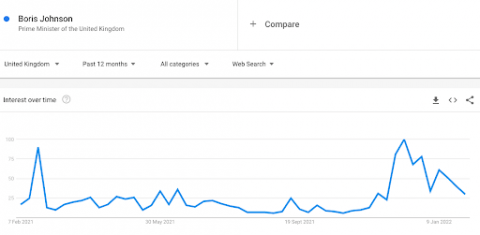 The next phase is to consider what stage of the content funnel your content falls into in regards to the customer journey and the user’s intent.
The next phase is to consider what stage of the content funnel your content falls into in regards to the customer journey and the user’s intent.
The stage of the funnel will impact how you use your keywords and will inform what type of content you will create:
| Hero | ‘Go big’ campaigns focused around topics relevant to your audience |
| Awareness | Educational and informational pillar content, such as ‘how to’ content |
| Consideration | Audience specific content to drive consideration of your brand and services |
| Conversion | Pages focusing on high intent keywords, such as product and category pages |
Once you have identified the stage of the funnel you’re writing for, it’s time to produce your content.
Below is a short checklist you can follow for best practice when producing high quality content:
- Naturally include target keywords
- Write for target customer profiles/personas
- Develop content that is shareable (this is ideal for building high quality links)
- Aim to solve users’ problems/answer customer questions
- Optimise for conversions with the inclusion of CTAs
- Use engaging and relevant visual content
Your content is your opportunity to add value to your website, as high quality content is one of the most important factors in the SEO process – ensure that you invest your time in honing and developing your website content.
2. Title tags
The page titles on your website are one of the most important elements of your on-page SEO. Title tags help both search engines and users to identify what they can find on your pages.
For a website to rank well, your focus keyword needs to be included for each page in the title tag. The keyword should be incorporated as naturally as possible.
Here’s our best practice tips below when producing page titles:
- The character length shouldn’t exceed 60 characters. Any longer than this may result in your title being cut off in the search results, which could impact your CTR
- Avoid ‘keyword stuffing’ your title – this is not only spammy but it also creates a negative reading experience. Modern search engines can pick up on this unnatural keyword stuffing so it could have an adverse effect on your rankings
- Ensure the title is relevant to the page
- Include your brand/business name in the title, such as “A Guide To On-Page SEO | Hallam”
 3. Meta descriptions
3. Meta descriptions
Meta descriptions are the piece of copy that appears underneath the clickable part of your search result. These short page descriptions are not ranking factors for search engines yet they can influence the click-through rate of your page, so it’s still an important aspect within on-page SEO. By using a structured markup, when your content is shared on social media, your descriptions can also be copied over to encourage clicks there as well.
By using a structured markup, when your content is shared on social media, your descriptions can also be copied over to encourage clicks there as well.
Here’s how to produce the perfect meta description:
- Keep the description under 160 characters to avoid Google cutting off part of the copy
- Include USPs and CTAs to entice users to click on your page in the SERPs
- Include your primary keyword. Google bolds words and phrases which match users’ search queries
- Match the intent of users, ensuring your description provides what users are looking for
4. URLs
Page URLs should be simple for both users and search engines to read so it is essential to keep them short and descriptive. Google will truncate your URL if it’s too lengthy, so it’s advisable to keep it short where possible.
URLs also keep your website hierarchy consistent as you add more internal pages such as subcategories and blog posts. So, it’s crucial that your URLs indicate the specific path to pages.
There are SEO plugins available that will make the process of updating URLs, title tags and meta descriptions easier, such as Yoast SEO.
Here are some further tips on producing SEO-friendly URLs:
- Include your primary keyword only so it is consistent with other optimisation elements
- Avoid using unnecessary words
- Make sure it is HTTPS to indicate to Google that your website is secure
- Separate words using hyphens
- Don’t use special characters or capital letters
5. Headings
Headings are another crucial part of on-page SEO. You may have also heard them being referred to as headers or body tags, but this is the HTML element that appears as <h1>, <h2> and <h3>.
These tags are responsible for organising your content for readers so they can find the information they are looking for. Headings also help search engines to identify which part of your content is most important and relevant based on search intent.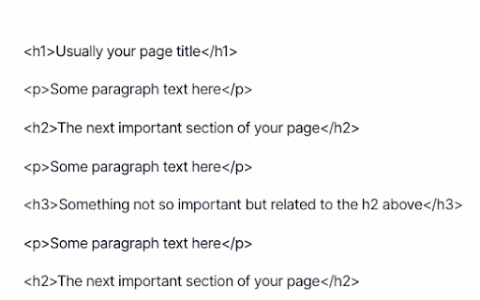
Within the H1 tag, you should include your primary keyword and ensure that this is consistent with your title tag, as users will be expecting the content to follow the headline they have clicked on in the search results. This will also be beneficial in aiding your optimisation for your target keyword.
Other headings such as H2s and H3s should also be included on your pages to logically structure your content. If it is natural to do so, you can also include secondary keywords here.
6. Image alt text
Many websites miss out on the opportunity rank in Google image searches by not optimising images. Image alt text tells search engines what your image is displaying.
This is important as Google delivers many image-based results, so it is a big advantage to rank for these searches.
The main purpose of alt text is to improve accessibility for users with screen readers. This converts content and images to audio so it’s important that you have descriptive alt text in place to guide users.
Keep these tips in mind when implementing image alt text:
- Be descriptive and accurate
- Ensure it is relevant to wider page content
- Keep it short and concise – no longer than 125 characters
- Use keywords if appropriate but avoid keyword stuffing
- Avoid using phrases such as “an image of” as Google and screen readers will recognise images and pictures

8. Structured Data
Structured data involves marking up website source code to allow Google to understand different elements of your content.
Google uses your structured markup to create the featured snippets, knowledge panels and other content features that can be found through Google searches. 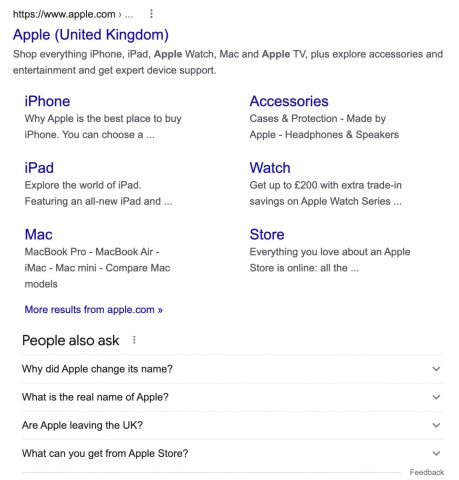 As mentioned in the meta descriptions section, structured data also ensures that page information shows up correctly when your content is shared on social media.
As mentioned in the meta descriptions section, structured data also ensures that page information shows up correctly when your content is shared on social media.
Structured data can be considered as more of a technical SEO tactic. However, as it can provide a better on-page experience for users, it’s important to implement it properly to aid on-page SEO, too.
9. Internal Links
Internal linking is the process of providing hyperlinks to other relevant and important pages on your website.
Including internal links is a crucial part of on-page SEO as these links send users to other pages on your website. This keeps visitors on your site longer and indicates to Google that your content is valuable.
Using keyword-enriched anchor text in your internal links also helps boost page rankings.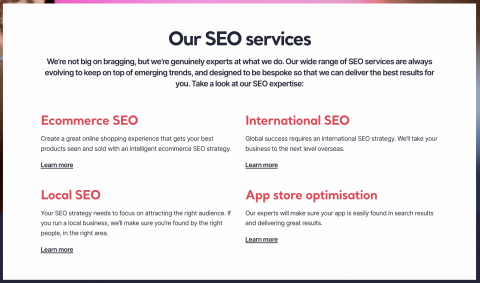 Internal links will ensure that Google indexes your pages, as search engines will crawl more of your content which can lead to your website ranking higher in the SERPs.
Internal links will ensure that Google indexes your pages, as search engines will crawl more of your content which can lead to your website ranking higher in the SERPs.
You can also include external links or outbound links that point to other websites that are writing about a similar topic.
Not only does this add depth and trust signals, which are great for Google, but it also aids your reader’s experience – it shows that you’re thinking about their needs and what else they might like to read about.
10. Mobile usability
As Google now favours websites that are optimised for better performance on mobile, usability and responsiveness on mobile is more important than ever.
Content layouts need to be readable and easy to navigate on mobile devices to provide great on page experience for users across all devices. You can test whether your page is up to standard on mobile using Google’s mobile friendly testing tool.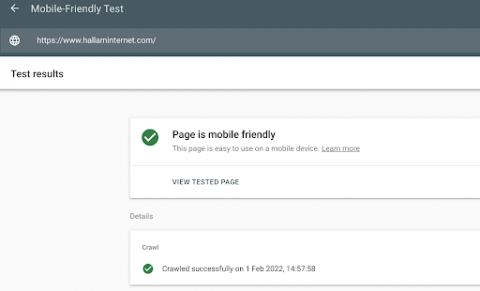
11. Site Speed
Site speed and load time are other important elements of on-page SEO. Whether users are viewing your pages on mobile or desktop, your website needs to load quickly.
User experience is highly valued by Google. If your website loads slowly, visitors are likely to leave your site and return to the search results to find alternative content – not only is this obviously bad for a positive user experience but Google also recognises this, which can lead to negative effects on rankings. This will also have a knock-on effect on conversions.
You can keep a close eye on the speed of your website using Google’s PageSpeed Insights Tool. Here you will also be able to determine whether your site is passing the Core Web Vitals test, to ensure that you are providing users with the best experience.
Here you will also be able to determine whether your site is passing the Core Web Vitals test, to ensure that you are providing users with the best experience.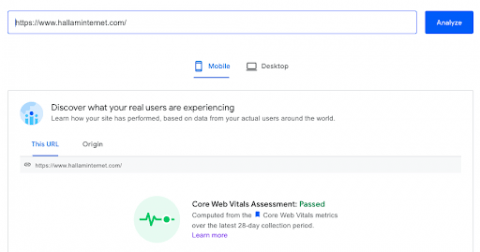
Final Thoughts
Follow the guide to on-page SEO above and your pages will become better optimised than your competitors. An important aspect to note is the common theme through all of the on-page factors is to add value and satisfy the user’s intent.
However, sadly decent SEO results aren’t just about focusing on any one area – for the best results, it’s vital that you should also ensure that your SEO team or SEO agency is improving the off-site and technical elements of your website to contribute to a successful SEO strategy.
Not sure where to start your own SEO strategy? Arrange a talk with one of our experts here.





